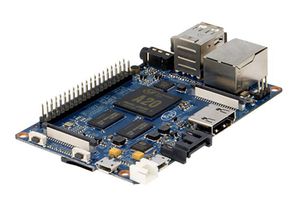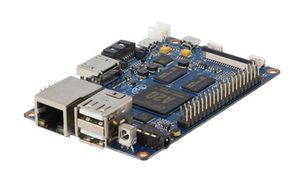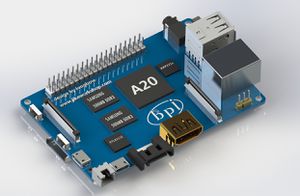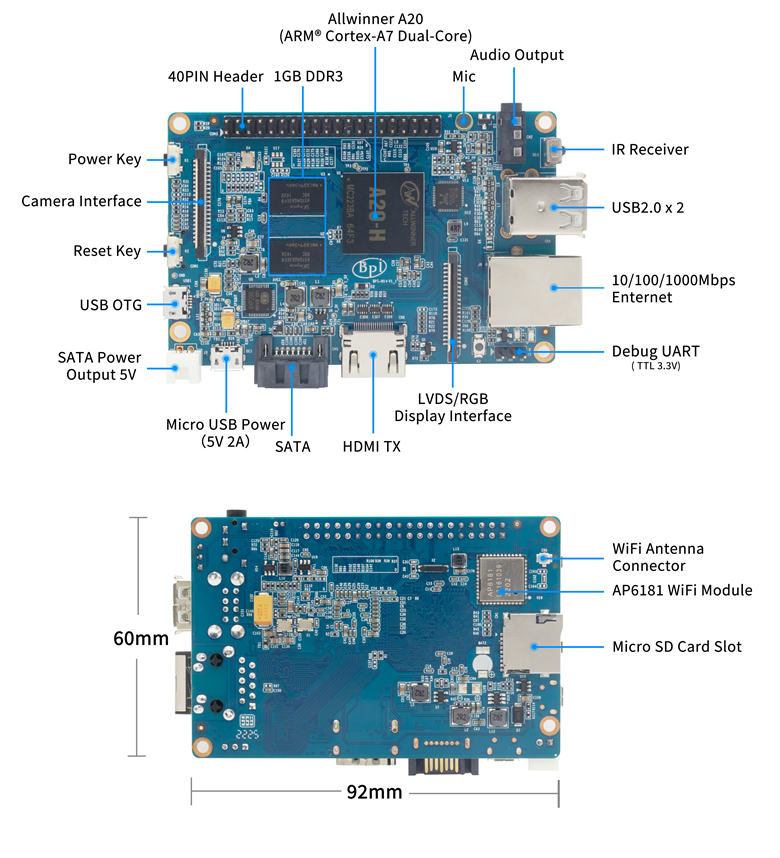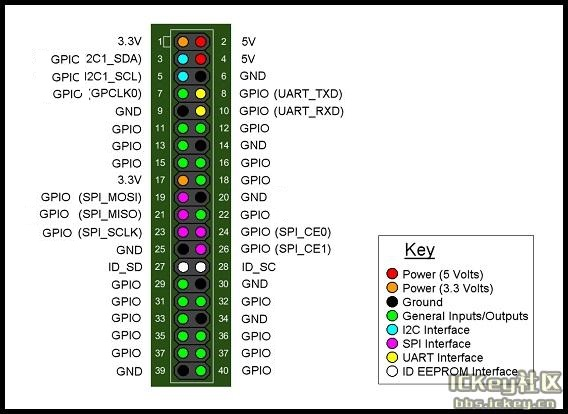Difference between revisions of "香蕉派 BPI-M1+"
(→Introduction) |
(→Get startting) |
||
| Line 39: | Line 39: | ||
* 3.7V lithium battery interface | * 3.7V lithium battery interface | ||
| − | == | + | ==开始使用 == |
*How to burn image : [[Quick Start Banana pi SBC]] | *How to burn image : [[Quick Start Banana pi SBC]] | ||
*How to development : [[Getting Started with M1P]] | *How to development : [[Getting Started with M1P]] | ||
Revision as of 01:32, 25 October 2018
介绍
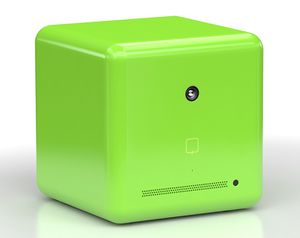
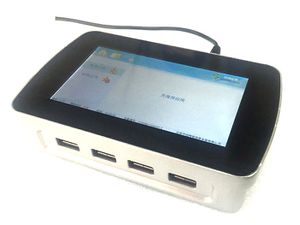
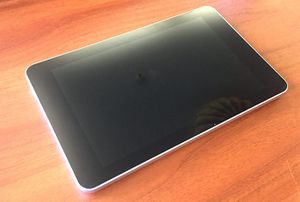
Banana Pi BPI-M1+是一款开源硬件单板电脑,为BPI-M1经典版本增加了更多的连接性。
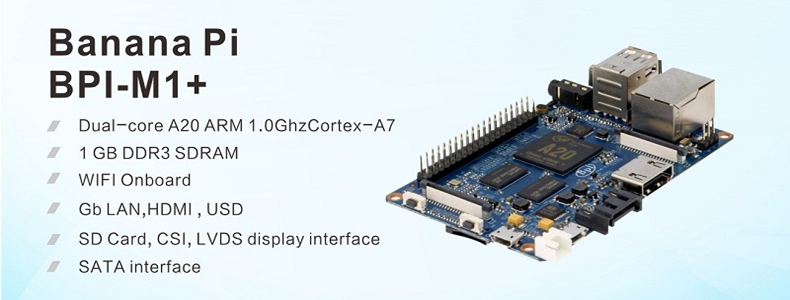
Banana PI BPI-M1+是一款高性能双核开源硬件单板计算机,Banana PI BPI-M1+是一款比树莓派 2B 更强悍的双核Android4.4与Linux产品。
Banana PI BPI-M1+兼容性强大,可以跑android系统,Debian linux,Ubuntu linux, Raspberry Pi系统 和 cubieboard 系统.
Banana PI BPI-M1+硬件:1Ghz ARM7双核处理器,1GB DDR3内存,千兆以太网口,板载SDIO接口的WIFI模块SATA Socket,流畅运行Android4.4。Banana PI BPI-M1+体积如信用卡大小,轻松运行《雷神之锤三:竞技场》这样的游戏,支持1080P高清视频输出,GPIO兼容Raspberry Pi 2并直接运行其ROM Image。
关键特性
- Allwinner A20 Dual-core 1.0GHz CPU
- Mali-400 MP2 with Open GL ES 2.0/1.1.
- 1 GB DDR3 memory.
- Wifi &BT support onboard
- 1x SATA interface.
- 1x Gigabit LAN
- 1x USB otg and 2x USB 2.0
- 1X MIC
- AV out
- HDMI out
- IR
- CSI camera interface
- DSI display interface
- 40 PIN gpio
- 3.7V lithium battery interface
开始使用
- How to burn image : Quick Start Banana pi SBC
- How to development : Getting Started with M1P
Hardware
Hardware interfact
Hardware spec
| Banana Pi BPI-M1+ | |||
| CPU | A20 ARM Cortex -A7 Dual-Core | ||
| GPU | ARM Mali400MP2Complies with OpenGL ES 2.0/1.1 | ||
| Memory | 1GB DDR3 | ||
| Network | 10/100/1000 Ethernet | ||
| wifi&BT | Wifi & BT 4.0 support onboard | ||
| Video Input | A CSI input connector allows for the connection of a designed camera module | ||
| Video Outputs | HDMI, CVBS, LVDS/RGB | ||
| Audio Outputs | 3.5mm jack and HDMI | ||
| Power Source | 5V/2A via Micro USB (DC in only) and / or Micro USB OTG | ||
| USB 2.0 ports | 2(direct from Allwinner A20 chip) | ||
| GPIO | GPIO, UART, I2C BUS, SPI BUS, WITH TWO CHIP SELECTS, CAN bus, ADC, PWM, +3.3V, +5V, GND | ||
| LED | Power Key & 8P8C | ||
| Storage | SATA 2.0 | ||
| OS | Android 4.4, Android 4.2, Raspbian, Lubuntu, Open Suse, Debian | ||
GPIO PIN define
Banana Pi BPI-M1+ has a 40-pin GPIO header that matches that of the Model Raspberry Pi 3. Following is the Banana Pi GPIO Pinout:
| 40 PIN GPIO of Banana pi BPI-M1+ | |||
| GPIO Pin Name | Default Function | Function2:GPIO | |
| CON3-P01 | VCC-3V3 | ||
| CON3-P02 | VCC-DC | ||
| CON3-P03 | TWI2-SDA | PB21 | |
| CON3-P04 | VCC-DC | ||
| CON3-P05 | TWI2-SCK | PB20 | |
| CON3-P06 | GND | ||
| CON3-P07 | PWM1 | PI3 | |
| CON3-P08 | UART3\_TX | PH0 | |
| CON3-P09 | GND | ||
| CON3-P10 | UART3\_RX | PH1 | |
| CON3-P11 | UART2\_RX | PI19 | |
| CON3-P12 | PH2 | PH2 | |
| CON3-P13 | UART2\_TX | PI18 | |
| CON3-P14 | GND | ||
| CON3-P15 | UART2\_CTS | PI17 | |
| CON3-P16 | CAN\_TX | PH20 | |
| CON3-P17 | VCC-3V3 | ||
| CON3-P18 | CAN\_RX | PH21 | |
| CON3-P19 | SPI0\_MOSI | PI12 | |
| CON3-P20 | GND | ||
| CON3-P21 | SPI0\_MISO | PI13 | |
| CON3-P22 | UART2\_RTS | PI16 | |
| CON3-P23 | SPI0\_CLK | PI11 | |
| CON3-P24 | SPI0\_CS0 | PI10 | |
| CON3-P25 | GND | ||
| CON3-P26 | SPI0\_CS1 | PI14 | |
| CON3-P27 | TWI3-SDA | PI1 | |
| CON3-P28 | TWI3-SCK | PI0 | |
| CON3-P29 | I2S\_MCLK | PB5 | |
| CON3-P30 | GND | ||
| CON3-P31 | I2S\_BCLK | PB6 | |
| CON3-P32 | I2S\_DI | PB12 | |
| CON3-P33 | I2S\_LRCK | PB7 | |
| CON3-P34 | GND | ||
| CON3-P35 | I2S\_DO0 | PB8 | |
| CON3-P36 | UART7\_RX | PI21 | |
| CON3-P37 | IR0\_TX | PB3 | |
| CON3-P38 | UART7\_TX | PI20 | |
| CON3-P39 | GND | ||
| CON3-P40 | SPDIF\_DO | PB13 | |
CSI Camera Connector specification:
The CSI Camera Connector is a 40-pin FPC connector which can connect external camera module with proper signal pin mappings.The pin definitions of the CSI interface are shown as below. This is marked on the Banana Pi board as “CON1″.
| CSI PIN of Banana pi BPI-M1+ | |||
| CSI Pin Name | Default Function Pin name | Function2:GPIO | |
| CON1 P01 | LINEINL | ||
| CON1 P02 | LINEINR | ||
| CON1 P03 | VCC-CSI | ||
| CON1 P04 | ADC\_X1 | ||
| CON1 P05 | GND | ||
| CON1 P06 | ADC\_X2 | ||
| CON1 P07 | FMINL | ||
| CON1 P08 | ADC\_Y1 | ||
| CON1 P09 | FMINR | ||
| CON1 P10 | ADC\_Y2 | ||
| CON1 P11 | GND | ||
| CON1 P12 | CSI-FLASH | PH17 | |
| CON1 P13 | LRADC0 | ||
| CON1 P14 | TWI1-SDA | PB19 | |
| CON1 P15 | LRADC1 | ||
| CON1 P16 | TWI1-SCK | PB18 | |
| CON1 P17 | CSI-D0 | PE4 | |
| CON1 P18 | CSI0-STBY-EN | PH19 | |
| CON1 P19 | CSI0-D1 | PE5 | |
| CON1 P20 | CSI-PCLK | PE0 | |
| CON1 P21 | CSI-D2 | PE6 | |
| CON1 P22 | CSI0-PWR-EN | PH16 | |
| CON1 P23 | CSI-D3 | PE7 | |
| CON1 P24 | CSI0-MCLK | PE1 | |
| CON1 P25 | CSI-D4 | PE8 | |
| CON1 P26 | CSI0-RESET\# | PH14 | |
| CON1 P27 | CSI-D5 | PE9 | |
| CON1 P28 | CSI-VSYNC | PE3 | |
| CON1 P29 | CSI-D6 | PE10 | |
| CON1 P30 | CSI-HSYNC | PE2 | |
| CON1 P31 | CSI-D7 | PE11 | |
| CON1 P32 | CSI1-STBY-EN | PH18 | |
| CON1 P33 | AP-RESET\# | ||
| CON1 P34 | CSI1-RESET\# | PH13 | |
| CON1 P35 | CSI-IO0 | PH11 | |
| CON1 P36 | HPR | ||
| CON1 P37 | HPL | ||
| CON1 P38 | IPSOUT | ||
| CON1 P39 | GND | ||
| CON1 P40 | IPSOUT | ||
LVDS \(LCD display interface\)
The LVDS Connector is a 40-pin FPC connector which can connect external LCD panel \(LVDS\) and touch screen \(I2C\) module as well.The pin definitions of this connector are shown as below. This is marked on the Banana Pi board as “CON2″.
| LVDS PIN of Banana pi BPI-M1+ | |||
| LVDS Pin | Default Function | Function2 | Function3:GPIO |
| CON2 P01 | IPSOUT\(5V output\) | ||
| CON2 P02 | TWI3-SDA | PI1 | |
| CON2 P03 | IPSOUT\(5V output\) | ||
| CON2 P04 | TWI3-SCK | PI0 | |
| CON2 P05 | GND | ||
| CON2 P06 | LCD0-IO0 | PH7 | |
| CON2 P07 | LCDIO-03 | PH12 | |
| CON2 P08 | LCD0-IO1 | PH8 | |
| CON2 P09 | LCD0-D0 | LVDS0-VP0 | PD0 |
| CON2 P10 | PWM0 | PB2 | |
| CON2 P11 | LCD0-D1 | LVDS0-VN0 | PD1 |
| CON2 P12 | LCD0-IO2 | ||
| CON2 P13 | LCD0-D2 | LVDS0-VP1 | PD2 |
| CON2 P14 | LCD0-DE | PD25 | |
| CON2 P15 | LCD0-D3 | LVDS0-VN1 | PD3 |
| CON2 P16 | LCD0-VSYNC | PD27 | |
| CON2 P17 | LCD0-D4 | LVDS0-VP2 | PD4 |
| CON2 P18 | LCD0-HSYNC | PD26 | |
| CON2 P19 | LCD0-D5 | LVDS0-VN2 | PD5 |
| CON2 P20 | LCD0-CS | ||
| CON2 P21 | LCD0-D6 | LVDS0-VPC | PD6 |
| CON2 P22 | LCD0-CLK | PD24 | |
| CON2 P23 | LCD0-D7 | LVDS0-VNC | PD7 |
| CON2 P24 | GND | ||
| CON2 P25 | LCD0-D8 | LVDS0-VP3 | PD8 |
| CON2 P26 | LCD0-D23 | PD23 | |
| CON2 P27 | LCD0-D9 | LVDS0-VN3 | PD9 |
| CON2 P28 | LCD0-D22 | PD22 | |
| CON2 P29 | LCD0-D10 | PD10 | |
| CON2 P30 | LCD0-D21 | PD21 | |
| CON2 P31 | LCD0-D11 | PD11 | |
| CON2 P32 | LCD0-D20 | PD20 | |
| CON2 P33 | LCD0-D12 | PD12 | |
| CON2 P34 | LCD0-D19 | PD19 | |
| CON2 P35 | LCD0-D13 | PD13 | |
| CON2 P36 | LCD0-D18 | PD18 | |
| CON2 P37 | LCD0-D14 | PD14 | |
| CON2 P38 | LCD0-D17 | PD17 | |
| CON2 P39 | LCD0-D15 | PD15 | |
| CON2 P40 | LCD0-D16 | PD16 | |
UART specification:
The jumper J11header CON4 is the UART interface.For developers of Banana Pi, this is an easy way to get the UART console output to check the system status and log message.
| UART debug PIN of Banana pi BPI-M1+ | |||
| Pin Name | Default Function | GPIO | |
| CON4 P03 | UART0-TXD | PB22 | |
| CON4 P02 | UART0-RXD | PB23 | |
| CON4 P01 | GND | ||
Software
Development
Basic Development
Resources
Source code
- Android 4.4 source code
Documents
- schematic diagram: google drive
- BPI-M1+ DXF file download link : google drive
- BPI-M1+ 3D design file download link :google drive
- CE FCC RoHS : BPI-M1 CE,FCC,RoHS
- Arch linux wiki for BPI-M1:https://wiki.archlinux.org/index.php/Banana_Pi
- Nas for BPI-M1/BPI-M1+ : https://www.hackster.io/jeffbaocai/bananapi-pro-nas-0815dc?ref=platform&ref_id=8064_popular___&offset=3
- NetBSD/evbarm on Allwinner SoCs : https://wiki.netbsd.org/ports/evbarm/allwinner/#index1h1
- Gentoo for banana pi : https://wiki.gentoo.org/wiki/Banana_Pi_the_Gentoo_Way
- openSUSE for banana pi : https://en.opensuse.org/HCL:BananaPi
- How to booting from SSD using Lubuntu / Raspbian :https://bananapi.gitbooks.io/bpi-m1/content/en/howtobootingfromssdusinglubunturaspbian.html
- Building the cluster on BPI : https://www.hackster.io/Penguinfly/banana-pi-cluster-47d566
- Allwinner documents:
- allwinner chip online datasheet and documents: http://dl.linux-sunxi.org/
Image Release
Android 4.4
- 2018-07-28 update android 4.4 HDMI version image
Armbian image
- Armbian Xenial and Armbian Jessie
- Image lownload link :https://www.armbian.com/banana-pi-plus/
OpenWRT
Officeal OpenWRT
- BPI-M1/BPI-M1+/BPI-R1 use A20 chip,so easy to run openwrt
- wiki : https://wiki.openwrt.org/toh/lamobo/r1
- openwrt support for allwinner :https://wiki.openwrt.org/doc/hardware/soc/soc.allwinner.sunxi?s[]=banana&s[]=pi
- image download : https://downloads.openwrt.org/chaos_calmer/15.05/sunxi/generic/uboot-sunxi-Lamobo_R1/
- opwrt for Allwinner Soc : https://wiki.openwrt.org/doc/hardware/soc/soc.allwinner.sunxi?s[]=banana&s[]=pi
BPI BSP for OpenWRT
- How to build OpenWRT image from github : https://bananapi.gitbooks.io/bpi-m1/content/en/howtobuildopenwrtimagefromgithub.html
FreeBSD
FreeBSD on Allwinner (sunxi) systems for banana pi
Banana pi as the official partner of Allwinner , must banana pi product use Allwinner chip design . such as A20/A31S/H3/H2+/A64/A83T , and FreeBSD have support many Allwinner . so easy to use on banana pi board.
- Allwinner A20 (sun7i), a dual-core Cortex-A7 BPI-M1/BPI-M1+/BPI-R1
- Allwinner A31 and A31s (sun6i), a quad-core Cortex-A7 BPI-M2
- Allwinner A64 (sun50i), a quad-core Cortex-A53 BPI-M64
- Allwinner A83T (sun8i), an octa-core Cortex-A7 BPI-M3
- Allwinner H3 (sun8i), a quad-core Cortex-A7 BPI-M2+/BPI-M2+ EDU/
https://wiki.freebsd.org/FreeBSD/arm/Allwinner
OpenSuse
- inmage and how to : https://bananapi.gitbooks.io/bpi-m1/content/en/opensuse.html
OpenMediaVault
- inmage and how to : https://bananapi.gitbooks.io/bpi-m1/content/en/openmediavault.html
Arch Linux
- inmage and how to : https://bananapi.gitbooks.io/bpi-m1/content/en/arch_linux.html
Gentoo Linux
- inmage and how to : https://bananapi.gitbooks.io/bpi-m1/content/en/gentoolinux.html
RaspBSD
- inmage and how to : https://bananapi.gitbooks.io/bpi-m1/content/en/raspbsdonbpi-m1.html
CentOS
- inmage and how to : https://bananapi.gitbooks.io/bpi-m1/content/en/centos7linuxforbpi.html
DietPi
- inmage and how to : https://bananapi.gitbooks.io/bpi-m1/content/en/dietpi.html
FreeBSD/NetBSD
- inmage and how to : https://bananapi.gitbooks.io/bpi-m1/content/en/freebsdnetbsd.html
Lakka TV
- Banana Pi M2+ with H3 chip
- Banana Pi M3 with A83T chip
- BPI-M1 and BPI-M1+ use A20 chip
- more about this : https://bananapi.gitbooks.io/bpi-m3/content/en/lakkatv.html
http://mirror.lakka.tv/nightly/
Simplenas
- simplenas image : https://simplenas.com/download/other/banana-pi-m1
